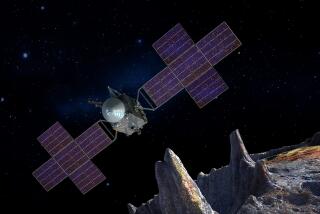The Rosetta orbiter is about to commit suicide, but first, a bit more science
- Share via
It was conceived when Ronald Reagan was in the White House. It launched a few weeks after Mark Zuckerberg created Facebook in his Harvard dorm. It spent a full decade looping around the solar system. And when it finally caught up with its target, it deployed the first probe to land on a speeding comet and survive.
Now the long, dramatic journey of the Rosetta space orbiter is about to end. After logging 4.9 billion miles, the craft is set to commit operational suicide in the wee hours of Friday morning, deliberately falling to the surface of 67P/Churyumov-Gerasimenko, the mountain-sized comet it has been following for the last two years.
But first it has just a bit more science to do.
During its final descent, Rosetta will gather close-range information about the comet and hastily beam data back to Earth before its main transmitter shuts off for good.
“It’s kind of bittersweet,” said Paul Weissman, a comet scientist at the Planetary Science Institute in Tucson who worked on Rosetta for 20 years. “You’d like to keep going, but it is also very satisfying. It’s been a tremendously successful mission.”

The European Space Agency’s Rosetta orbiter will commit operational suicide early Friday morning, but first it has just a little bit more science to do.
The $1-billion mission has been full of suspense.
Its many plot twists began before the spacecraft left Earth, when a faulty rocket postponed the launch by two years and caused mission planners at the European Space Agency to abandon their original comet and select a different one instead.
The new comet, known as 67P, was four times larger than the initial target, and meeting up with it required a longer flight than originally planned. Between March 2004 and January of 2014, Rosetta made three Earth flybys and one close pass by Mars, using the plantets’ gravity to give it a boost.
Along the way, it imaged two asteroids and endured a hibernation of two years, seven months and 12 days.
Engineers programmed four alarm clocks to wake the spacecraft from its epic slumber. Everything hinged on its ability to boot back up, said Rosetta Flight Director Andrea Accomazzo.
“Either we had a mission, or we had no mission at all,” he said.
Accomazzo got the wake-up signal Jan. 20, 2014 — 40 nail-biting minutes late.
Scientists are fascinated by comets because they believe the mysterious bodies were formed in the earliest days of the solar system, and that frozen into their icy nuclei are the same primordial materials that make up the planets.
As Rosetta closed in on its target, researchers were dazzled by the strange and unexpected shape that gradually came into focus. The comet was roughly 2.5 miles across and had two distinct lobes that resembled a rubber duck with a head, thin neck and bulbous body. In time, Rosetta’s instruments revealed a dramatic world of towering cliffs, deep pits and massive boulders.
“It was a big surprise,” said Claire Vallat, a scientist at the agency’s European Space Astronomy Center.
After officially entering 67P’s orbit on Aug. 6, 2014, Rosetta spent several months mapping the surface to find the best spot to send Philae, its 220-pound washing-machine-sized lander. The mission team ultimately selected what the late NASA scientist Claudia Alexander described as “the least-worst option” — a site that got enough sunlight to power Philae’s solar panels, and that appeared to have shallower slopes and fewer boulders than other areas.
On Nov. 12, 2014, scientists were once again on the edge of their seats as Philae made a slow, seven-hour descent to the surface of 67P. It was humanity’s first attempt to make a soft landing on a comet.
The unprecedented maneuver did not go exactly as planned. The lander’s harpoons failed to fire and Philae bounced twice before coming to rest in what remained an unknown location for nearly two years.
It soon became clear that Philae’s solar panels would not receive enough sunlight to keep powering the onboard instruments, so it was able to conduct experiments for only 60 hours before shutting down. But mission scientists insist that Philae is no failure.
“Philae sent back quite a bit of information for three days,” Weissman said. “We didn’t learn everything we wanted to from the lander, but we did learn a lot.”
In the meantime, Rosetta continued to orbit the comet as it made its closest approach to the sun in August 2015. From a safe distance of 186 miles, it watched as 67P became more active, with streams of dust and gas shooting off its surface. The comet’s display subsided as it flew further from the sun.
“Rosetta had a major goal in mind, which was to rendezvous with a comet far from the sun and watch it wake up and then let it die down again” said Laurence O’Rourke, a lander systems engineer at ESA. “Overwhelmingly, we have met that goal.”
But the drama was not over yet. Less than one month before the mission’s end, Rosetta’s cameras finally spotted Philae wedged into a dark crack on the comet’s surface. Two of its legs were sticking up in the air.
Finding Philae after all that time ”was like drinking a bottle of adrenaline,” O’Rourke said. “I couldn’t sleep for the whole night.”
Now Rosetta has reached the end of its journey. Comet 67P is on its way toward the orbit of Jupiter, and soon Rosetta’s 100-foot solar panels will be too far from the sun for the spacecraft to function.
“Operating Rosetta beyond this point wouldn’t be possible,” Accomazzo said.
Experts say there is no chance the orbiter will survive its Friday morning collision with the comet.
Although the last few minutes of its life are difficult to predict, researchers expect it to hit 67P at a walking pace of slightly less than 3 feet per second. When it lands, it will tumble and bounce before settling into its final resting place on the small lobe of the comet. The impact will kick up a few clouds of dark, powdery dust. Then a preprogrammed computer command will turn off its transmitters forever.
But this final death dive will not be made in vain.
The lander will be pointed toward the Ma’at region, which is home to several pits about 320 feet across and 100 feet deep. When the comet was closer to the sun and more active, jets of dust came shooting out of these pits, making them an intriguing place for study.
In addition, researchers have spotted lumpy structures on the pit walls that might be cometessimals, the building blocks of the comet. Scientists are eager to get a closer look.
“The plan is to go as low as possible and transmit as late as possible,” Vallat said.
Here on Earth, hundreds of scientists and engineers will gather at the European Space Operations Center in Darmstadt, Germany, to watch for the flattening of the radio signal that will let them know Rosetta has gone offline forever.
“To be honest, I’m not sure how I feel,” said Matt Taylor, project scientist for the mission. “I’m relieved to be losing some of the burden that is operations, but also sad that we won’t have that aspect of ‘new’ observations.”
Already, data collected by Rosetta has led to the publication of hundreds of scientific papers. Measurements taken by the orbiter’s suite of instruments suggest that 67P has a higher dust-to-water ratio than expected, forcing scientists to change their view of comets as dirty snowballs and instead think of them as icy dust balls. High-resolution images of the comet’s surface have led to new theories about the processes that created the unexpected terrain.
Observations of nitrogen and different types of water in 67P’s atmosphere suggest the comet formed far from the sun, and because the molecular fingerprint of the water is different from what we find in Earth’s oceans, researchers have concluded that comets did not play a major role in delivering water to our planet, as some had thought.
One of the biggest surprises was the discovery of molecular oxygen on the comet. Although oxygen is abundant on Earth, it is quite rare in the universe and had never been seen on a comet. Computer models suggest that all of the molecular oxygen should have combined with hydrogen at the dawn of our solar system, so its presence on 67P is a puzzle scientists are still working out.
“There were things we thought we knew about comets that were very well confirmed, and things that we thought we knew that were totally wrong,” Weissman said.
Do you love science? I do! Follow me @DeborahNetburn and “like” Los Angeles Times Science & Health on Facebook.
MORE SCIENCE NEWS
Eye-tracking technology shows that preschool teachers have implicit bias against black boys
Geysers of water vapor shooting from Europa could offer taste of ocean within
For patients who need bone grafts, a 3D-printer could come to the rescue







